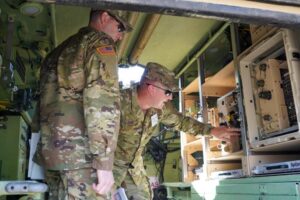TAUNTON, Mass. — The Army will run a pilot program early next year to inform requirements for bringing new on-the-move (OTM) communications transport capacity to its armored brigade combat teams (ABCT), a key component for the service’s third network modernization capability drop slated for fielding in fiscal year 2025.
General Dynamics Mission Systems [GD] is serving as the prime integrator for the effort, and is currently outfitting a set of 16 surrogate vehicles with a range of satellite and line-of-communications capabilities ahead of the test event at Fort Stewart in Georgia in late January and February.

“This is an opportunity to look at a variety of technologies across maturity levels from a [concept of operations] perspective of how we would employ and execute the kit,” Col. Shane Taylor, the Army’s program manager for tactical networks, told reporters during a visit to GD Mission Systems’ facility here where the integration effort is taking place. “We asked GD to serve as the lead integrator for this. Quite honestly, they have a tremendous amount of domain expertise in this area. And they’ve done a good job working with partners from across the spectrum, from terminal providers to modem providers.”
The Army is transforming its tactical network through two-year capability drops, with CAPSET 21 currently being fielded, CAPSET 23 in the final development stages ahead of a critical design review in April 2022 and officials currently working to inform characterization for CAPSET 25’s network design goals (Defense Daily, June 2).
GD Mission Systems was selected to work on the pilot effort in 2020, and has since collaborated with the Army on selecting a group of more than 20 technologies that will be outfitted on the platforms with the goal of gathering soldier feedback on the best mix of systems required to provide ABCTs bolstered network transport capability while ensuring reduced complexity for users and not taking up too much space within the vehicles.
“We’ve kind of flipped the script now and we’ve worked with industry to identify capability gaps and technologies. We get those in the hands of soldiers early, that’s what the pilot for ABCT is, and you get that real-time feedback. Then we use that to shape and inform the requirements,” Taylor said. “Really, we’re trying to let the technology drive the requirements, as opposed to traditionally where the requirements somewhat drove the technology.”
Currently, GD Mission Systems is integrating the set of capabilities on 12 M1068s and four Humvees, while the Army noted the pilot is providing insight into future networking requirements for platforms such as the new AMPVs and JLTVs.
“Meeting our objective with trying to keep it simple was to modularize our approach so you get a common look and feel for a similar set of equipment and rack structure that goes in each of the [different] vehicles, albeit with different equipment suites in them,” Ed Reber, GD Mission Systems’ acting director for the ABCT business area, told reporters. “Even though these are not the platforms that will be eventually fielded on for production, the approach we’re taking will be able to migrate to that. We’ll be able to take the same design approaches, change variables associated with the new AMPVs and JLTVs and be able to rapidly incorporate those updates and changes for those vehicles.”
The pilot effort is specifically focused on assessing three different ABCT OTM configurations, or employment concepts, with the Army planning to leverage soldier feedback to inform what is the correct mix of capabilities that will then be pursued as part of CAPSET 25. Each configuration features four M1068 surrogates: an S6 with full capability to function as a command post, an S2 for intelligence, S3 for operations and a Fires platform.
The most robust configuration includes a Get Sat MilliSat Terminal for OTM SATCOM, Silvus S/C 4480E and Triad RF THPR1021 mesh radio systems for line-of-sight capability, a 1.2M Airbus Ranger VSAT for at-the-quick-halt SATCOM and a Hoverfly tethered drone for range extension.
From there, Army officials detailed a second configuration that includes a Kymeta U8 terminal providing OTM SATCOM capability but without line-of-sight tools for the S2, S3 and Fires platforms. A third configuration includes a SATCOM link via a ThinKom ThinSat 300 terminal for the S6 platform while the remaining three platforms have Persistent Systems GVR5 for line-of-sight but no SATCOM capability.
“We’re not talking push-to-talk…these are key staff enablers that have a higher data throughput. They need to pull more information, be it intelligence, operational graphics or photos of where we’re trying to get to. This capability gap is the ability to, on the move…harvest that key data,” Col. Greg Napoli, the unified network lead for the Army’ Network Cross Functional Team, told reporters. “What we’re doing is we’re taking something that used to be in a tent, we’re miniaturizing it, we’re putting it on a vehicle and allowing that staff to provide the information that a commander needs to make decisions extraordinarily rapidly while they’re moving.”
Army officials will brief on the pilot’s results by the third quarter of fiscal year 2022, with Taylor noting the preliminary design review for CAPSET 25 is scheduled for April 2023.
The Army is currently working through two-year capability drops to transform its tactical network, with CAPSET 21 currently being fielded and CAPSET 23 in the final development stages ahead of a critical design review in April 2022.